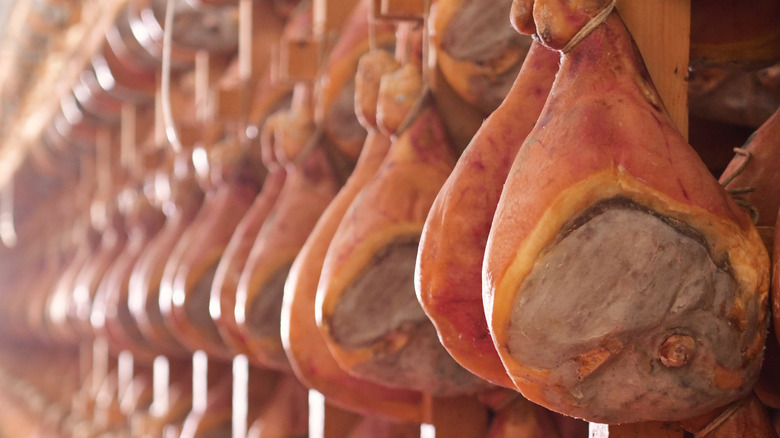What Sets Prosciutto Di Parma Apart From Other Varieties
Prosciutto Crudo di Parma is considered the King of Hams, reports Eataly, and has reigned supreme since its first mention back in 100 B.C. by Cato, the Elder, who marveled at the taste of the air-cured ham. Produced in the Italian city of Parma, this prosciutto has become the favorite cured ham of many. But what exactly sets Prosciutto di Parma apart from other varieties?
Before we get into the specifics, let's walk through a quick Italian lesson. Chef Travel Guide explains that prosciutto translates to ham, which can be divided into two categories: crudo (raw and cured like Prosciutto di Parma) or cotto (salt-cured and steamed). That said, not all prosciutto crudo is made the same way, nor does it all come from Parma. Smoky Speck, herbed Prosciutto Toscano, and wine-cured culatello are just some of the cured varieties in Italy, but prosciutto is made all over the world like Spain (Jamón Iberico) and even in the U.S.
Taste, of course, is the main component that makes Prosciutto di Parma so special. A freshly aged leg is mild and delicately sweet with a buttery texture that's ideal for cooking. As it ages, Bon Appétit notes that its taste becomes more complex as it develops nutty, earthy flavors. It also becomes drier in texture and darker in color. But flavor profile isn't the only reason the cured ham hailing from Parma is exceptional.
The strict regulations rooted in tradition
According to the Consorzio di Prosciutto di Parma, producers must follow strict guidelines to produce an authentically cured ham, confirmed with D.O.P. status. For example, only the hind legs of select, specially-fed, free-range pigs are used. But the process only gets more particular.
Pork legs are salted by a skilled professional and left to rest twice before being washed and hung to dry naturally — something Saveur says gives Prosciutto di Parma an edge. Then, the hams are rubbed with lard to preserve moisture before continuing to age in a dark cellar between 14 to 36 months. At this point, an inspector pokes the prosciutto with a wooden needle as a quality check before the ham is branded with the iconic crown-shaped stamp.
In essence, what differentiates Prosciutto Crudo di Parma, notes Parma Crown, is that the cured meat must be produced in Parma following traditional methods that rely solely on sea salt, air, and time — that means it's free of additives, preservatives, and coloring agents. While other prosciutto variations exist, the attention to detail and lack of things like nitrates make Parma Ham a cut above the rest.
Perfect on its own or accompanied with cheese and bread, thinly sliced Prosciutto di Parma is best served at room temperature, with the pearly layer of fat intact as it helps add balance to the rich meatiness. Prosciutto and melon, anyone?

